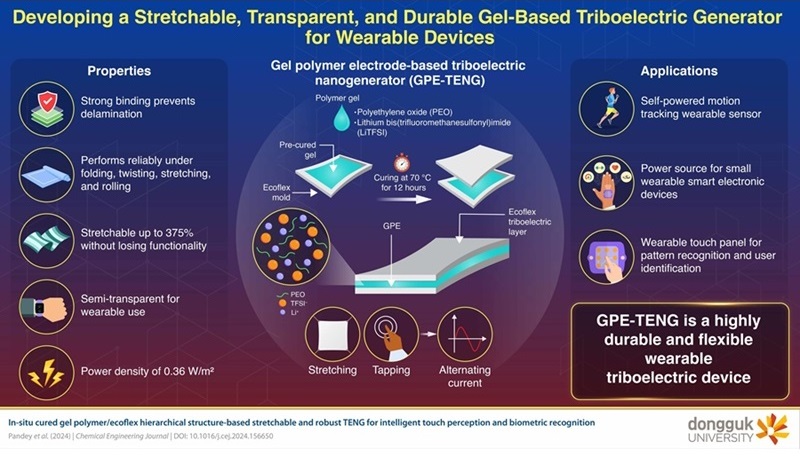Gel-Based Stretchable Triboelectric Nanogenerators to Revolutionize Wearable Technology
|
By HospiMedica International staff writers Posted on 20 Dec 2024 |

Wearable technology, ranging from fitness trackers and smartwatches to medical sensors worn on the body, is revolutionizing our interaction with technology. As these devices gain in popularity, triboelectric nanogenerators (TENGs), which convert mechanical energy, such as body movement, into electrical energy, offer a way to power them without the need for batteries. Most TENGs in wearable applications use a triboelectric material attached to an electrode that conducts electrical current. However, one of the challenges has been finding flexible electrode materials that can move naturally with the human body. To solve this, researchers have developed a gel polymer electrode-based triboelectric nanogenerator (GPE-TENG). This device, described in research published in the Chemical Engineering Journal, is stretchable, semi-transparent, and durable, making it ideal for use in wearable sensor applications.
The research team from Dongguk University (Seoul, Republic of Korea) fabricated the device by pouring a gel mixture of polyethylene oxide (PEO) and lithium bis(trifluoromethanesulfonyl)imide (LiTFSI) into an ecoflex mold. The gel is evenly spread and covered with another layer of ecoflex. A copper wire is connected to the gel to allow for electrical flow, and the entire assembly is cured at 70°C for 12 hours, ensuring a strong bond between the gel and the ecoflex layers. The resulting device is durable, flexible, and semi-transparent, generating electrical signals when tapped or stretched, with a peak power output of 0.36 W/m² at a load of 15 MΩ. During testing, the device was able to stretch up to 375% of its original size without damage, and it endured two months of bending, twisting, folding, and stretching without any signs of delamination or performance loss. As wearable technology becomes increasingly integral to daily life, the GPE-TENG could enable devices that monitor joint activity for rehabilitation or function as biometric systems in clothing, potentially allowing users to unlock smart doors or lockers.
“This work could revolutionize wearable technology by developing sustainable and flexible electronic devices with promising applications in human healthcare, rehabilitation, security systems, and secure biometric authentication systems,” said Professor Jung Inn Sohn from Dongguk University who led the research team.
Latest Critical Care News
- Novel Cannula Delivery System Enables Targeted Delivery of Imaging Agents and Drugs
- Ingestible Smart Capsule for Chemical Sensing in the Gut Moves Closer to Market
- Novel Intrabronchial Method Delivers Cell Therapies in Critically Ill Patients on External Lung Support
- Generative AI Technology Detects Heart Disease Earlier Than Conventional Methods
- Wearable Technology Predicts Cardiovascular Risk by Continuously Monitoring Heart Rate Recovery
- Wearable Health Monitoring Device Measures Gases Emitted from and Absorbed by Skin
- Groundbreaking Technology Rapidly Detects Airborne Influenza Viruses
- Handheld Device Could Transform Heart Disease Screening
- Flexible Semi-Autonomous Robot Could Deliver Medicine Inside Body

- Neurorestorative Treatment Strategies Hold Promise for Most Severe Forms of Epilepsy
- Gene Discovery Could Help Grow New Heart Arteries
- Study Discovers Invisible Transmission of Common Hospital-Associated Infection
- Non-Invasive Neuro-Ophthalmology Techniques Could Detect Brain Tumors Earlier
- Mass Manufactured Nanoparticles to Deliver Cancer Drugs Directly to Tumors
- World’s Smallest Pacemaker Fits Inside Syringe Tip

- AI-Powered, Internet-Connected Medical Devices to Revolutionize Healthcare, Finds Study
Channels
Surgical Techniques
view channel
Pioneering Sutureless Coronary Bypass Technology to Eliminate Open-Chest Procedures
In patients with coronary artery disease, certain blood vessels may be narrowed or blocked, requiring a stent or a bypass (also known as diversion) to restore blood flow to the heart. Bypass surgeries... Read more
Intravascular Imaging for Guiding Stent Implantation Ensures Safer Stenting Procedures
Patients diagnosed with coronary artery disease, which is caused by plaque accumulation within the arteries leading to chest pain, shortness of breath, and potential heart attacks, frequently undergo percutaneous... Read more
World's First AI Surgical Guidance Platform Allows Surgeons to Measure Success in Real-Time
Surgeons have always faced challenges in measuring their progress toward surgical goals during procedures. Traditionally, obtaining measurements required stepping out of the sterile environment to perform... Read morePatient Care
view channel
Portable Biosensor Platform to Reduce Hospital-Acquired Infections
Approximately 4 million patients in the European Union acquire healthcare-associated infections (HAIs) or nosocomial infections each year, with around 37,000 deaths directly resulting from these infections,... Read moreFirst-Of-Its-Kind Portable Germicidal Light Technology Disinfects High-Touch Clinical Surfaces in Seconds
Reducing healthcare-acquired infections (HAIs) remains a pressing issue within global healthcare systems. In the United States alone, 1.7 million patients contract HAIs annually, leading to approximately... Read more
Surgical Capacity Optimization Solution Helps Hospitals Boost OR Utilization
An innovative solution has the capability to transform surgical capacity utilization by targeting the root cause of surgical block time inefficiencies. Fujitsu Limited’s (Tokyo, Japan) Surgical Capacity... Read more
Game-Changing Innovation in Surgical Instrument Sterilization Significantly Improves OR Throughput
A groundbreaking innovation enables hospitals to significantly improve instrument processing time and throughput in operating rooms (ORs) and sterile processing departments. Turbett Surgical, Inc.... Read moreHealth IT
view channel
Printable Molecule-Selective Nanoparticles Enable Mass Production of Wearable Biosensors
The future of medicine is likely to focus on the personalization of healthcare—understanding exactly what an individual requires and delivering the appropriate combination of nutrients, metabolites, and... Read more
Smartwatches Could Detect Congestive Heart Failure
Diagnosing congestive heart failure (CHF) typically requires expensive and time-consuming imaging techniques like echocardiography, also known as cardiac ultrasound. Previously, detecting CHF by analyzing... Read moreBusiness
view channel
Expanded Collaboration to Transform OR Technology Through AI and Automation
The expansion of an existing collaboration between three leading companies aims to develop artificial intelligence (AI)-driven solutions for smart operating rooms with sophisticated monitoring and automation.... Read more
















